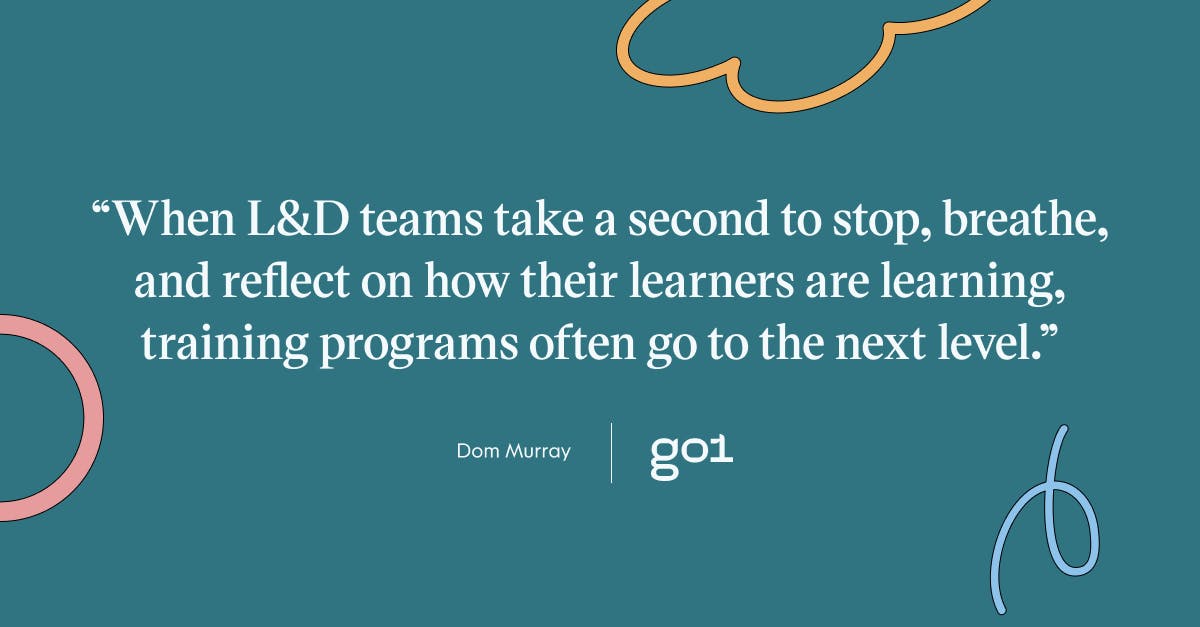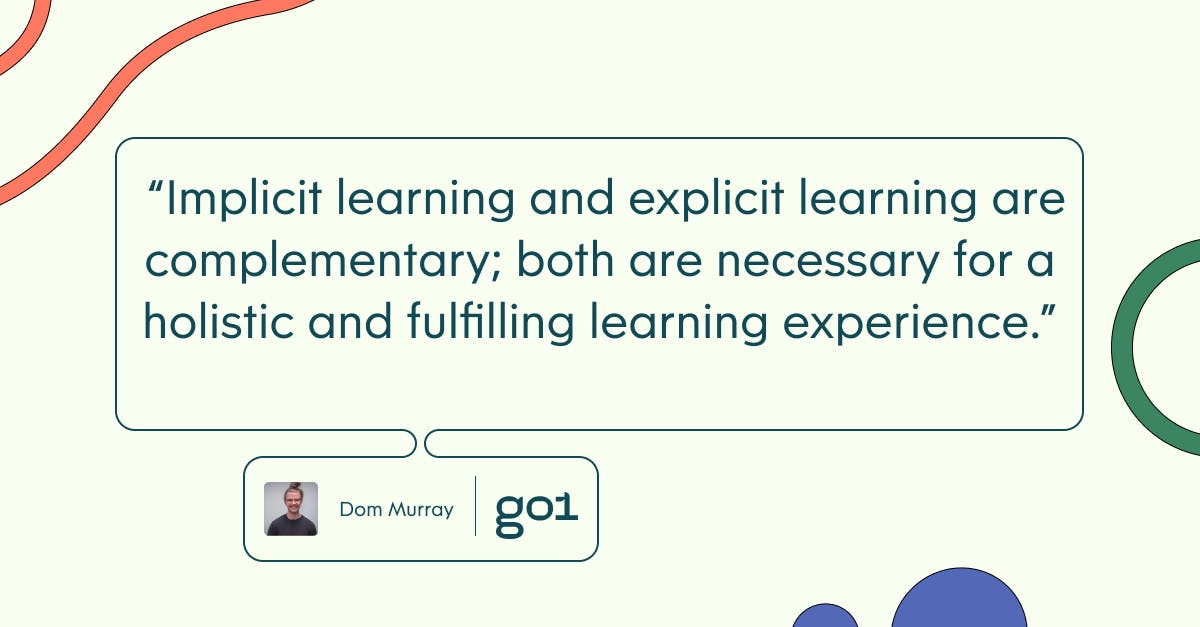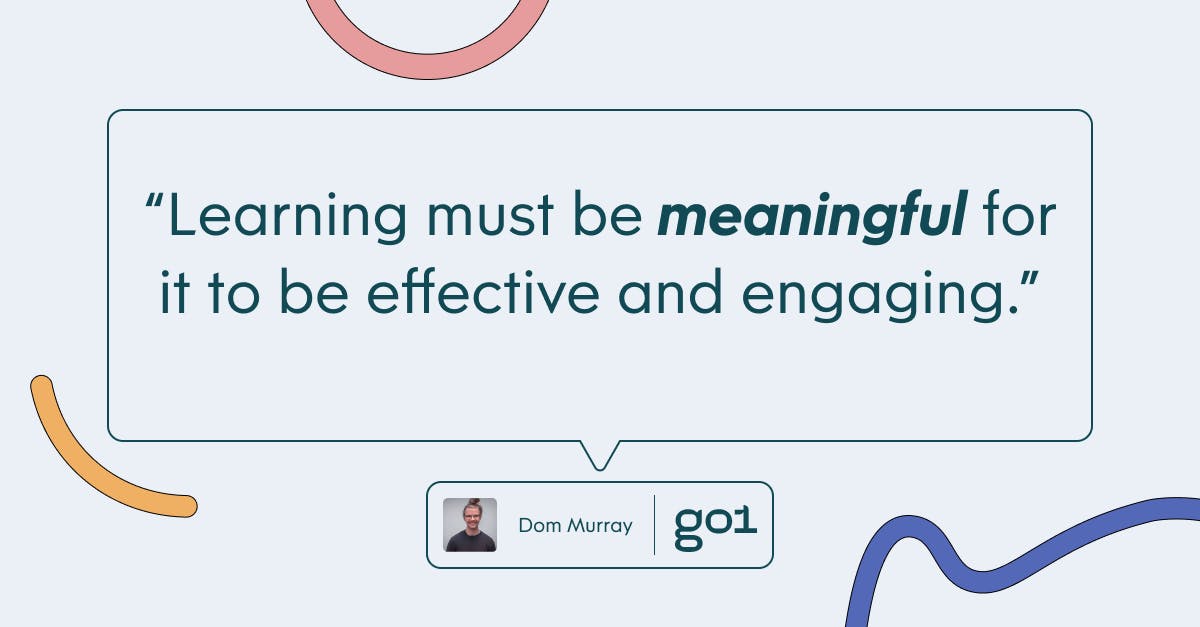
What strategies should L&D teams use to apply cognitive learning theory?

Too often, L&D teams get caught up in the rapid rush of workplace learning. You have to produce that next learning module yesterday, meaning there’s never time to reflect on the last one, let alone stop and smell the roses. While this fast-paced environment can have its benefits, when L&D teams take a second to stop, breathe, and reflect on how their learners are learning, training programs often go to the next level.

As discussed in the first article in this series, which analysed the benefits of cognitive learning theory, this idea of learning about learning (metacognition) is a central pillar of cognitive learning theory.
So, in the second and final article of our cognitive learning theory series, we’ll build on this foundation by asking: what strategies should L&D teams use to apply cognitive learning theory? We’ll examine three strategies to apply cognitive learning theory at work, including implicit and explicit learning, collaborative learning, and meaningful learning.
But first, if you need a quick refresher on cognitive learning theory before diving into this article, here’s a brief explainer from our previous article:
“Cognitive learning theory focuses on metacognition. That is, thinking about thinking or learning how to learn. When we engage in cognitive learning, learning becomes an ongoing and engaging lifelong pursuit, rather than a dull, automatic reaction.”
With that in mind, the question becomes, what steps can my L&D team take to engage in cognitive learning? Here are three strategies to help you and your team apply cognitive learning theory at work.
Understand implicit & explicit learning
Implicit and explicit learning are central concepts within cognitive learning theory. In simple terms, implicit learning means learning without conscious effort, whereas explicit learning requires conscious effort.
Implicit learning
Implicit learning, sometimes known as accidental, automatic, or subconscious learning, happens when you are not actively aware that you are learning but later notice you have retained or solidified knowledge. Therefore, implicit learning occurs on a subconscious level.
As Science Direct puts it, implicit learning is “the non-intentional acquisition of knowledge about structural relations between objects or events.”
Examples of implicit learning include: walking, talking, eating, riding a bike, dancing, and many more — whenever you're learning without conscious thought, that's implicit learning.
The Brain Based Learning blog elaborates on this point, offering further examples of implicit learning, including: “movements (sports, games and play), trauma (emotional learning), stimulus-response learning (hand on the hot stove), generalised learning (the nonconscious extraction of patterns), procedural learning (riding a bike) and imitation learning (learning by demonstration).”
In an L&D context, implicit learning usually takes the form of skill improvements that occur while employees perform their job. In this way, learners consolidate knowledge subconsciously while their brain is actively consumed with other tasks. For example, you may learn to type without looking at your keyboard or improve your analytical skills while working on another task.
Explicit learning
On the other hand, explicit learning occurs consciously, often via assigned training or formal learning at school or university. Any time you actively and deliberately seek knowledge, that is a form of explicit learning.
Examples of explicit learning are manifold, from reading a book, to enrolling in an online learning course, to watching a documentary, and everything in between.
360 Learning outlines the benefits of explicit learning for L&D teams, noting, “through explicit learning tasks, you can specify the exact concepts and skills that you want a team member to understand.”
Indeed ties explicit learning back to cognitive learning, explaining that “cognitive learning helps you to learn more explicitly by giving you exceptional insight into the subject and how it relates to your work now and later.”
Learning studies
Now that we understand what implicit learning and explicit learning are, it’s worth analysing the benefits of each. There have been many studies into implicit and explicit learning, intending to understand how people learn and process information. One such study analysed 34 adults, ranging from 21-36 years old.
During the study, the subjects learned pseudowords. That is, “words that are similar to real words but that have no meaning, such as ‘skoat’ or ‘chote.’” The subjects then learned the definition of these words through both implicit and explicit learning.
Ultimately, all subjects successfully learned the pseudowords. However, functional magnetic resonance imaging (fMRI) found that subjects previously identified as excellent readers showed little difference in processing explicit and implicit instruction. In contrast, ‘average’ readers had to work harder to learn through implicit instruction. For these subjects, explicit instruction was the more effective method.
Summarising implicit vs explicit learning
Of course, this is just one of many studies and not an indication that explicit learning is always superior to implicit learning. Quite the opposite. If anything, implicit learning and explicit learning are complementary; both are necessary for a holistic and fulfilling learning experience.

As 360 Learning summarises: “a learning organisation counts on active (explicit) and continuous (implicit) learning to keep employees engaged. As team members guide their active learning strategies together, they participate in ongoing learning through shared experiences.”
In the context of cognitive learning theory, it is vital to have a working understanding of both implicit and explicit learning. By understanding these important learning processes, we can deepen our knowledge and approach learning from a more informed and considered place. After all, cognitive learning theory focuses on learning about learning. So — particularly in the case of implicit learning — it’s crucial to understand how we regularly gain knowledge without even realising it!
Prioritise collaborative learning
Collaborative learning is another core tenet of cognitive learning theory. As the name suggests, collaborative learning occurs when groups of two or more learners work together to learn, solve problems, or share new concepts.
As Indeed explains: “collaborative learning is a cognitive strategy in which a resource person teaches a group how to develop their ideas on a specific skill or knowledge area. For instance, your company could train a colleague on a new production process so they can pass on the knowledge to team members.”
Solving problems across teams, evaluating training systems, creating learning content, and even developing new products are all examples of collaborative learning at work.
The benefits of collaboration
According to Valamis, one of the critical advantages of collaborative learning is that it “actively engages learners to process and synthesise information and concepts, rather than using rote memorisation of facts and figures.”
And this is just the tip of the iceberg. The benefits of collaborative learning for L&D teams are wide-ranging. For starters, 75% of employees rate teamwork and collaboration as very important, while, on average, employees are 17% more satisfied with their job when they collaborate frequently at work.
Another study found that top-performing workers spend 45% of their time working individually, 45% of their time collaborating, and 10% of their time learning and socialising.
Further, a study by Stanford found that employees who work collaboratively are 64% more likely to stick to their assigned tasks than their peers who work individually.

Deloitte has even attempted to quantify the value of collaboration, finding that improvements made due to workplace collaboration are worth a massive $2,517 per employee per year.
Collaborative learning studies
Many studies have sought to quantify the benefits of collaborative learning compared to solo learning. One of these studies involved 71 Year 7 students learning statistics at school. During the study, students learned via both hands-on, collaborative activities and individual worksheet-based instruction.
The study found an 11.8% increase in test scores when students worked collaboratively. Moreover, 96% of students said that working collaboratively enhanced their understanding of the subject matter. Most students also thought they gained more knowledge while better understanding specific skills and processes when working collaboratively.
Further research by Josh Bersin found that when studying alone, learners typically remember just 28% of the material two days later. When you re-read the material to consolidate knowledge, this figure rises to 46%.
However, when learners answer questions about the material and collaborate with others, they remember 69% two days later, equating to a 146% increase in retention. According to Josh Bersin, this is because “actually conceptualising, recalling, and using information is what creates the ‘memory pathways’ that stick in your mind.”
Again, understanding and actively engaging in collaborative learning is central to cognitive learning theory, making us more mindful of how we learn.
Focus on meaningful learning
Last, but certainly not least, L&D teams would be wise to focus on meaningful learning when applying cognitive learning theory. American psychologist David Ausubel popularised the concept of meaningful learning, believing that learning must be meaningful for it to be effective and engaging.

According to Ausubel: “meaningful learning occurs when the learner interprets, relates, and incorporates new information with existing knowledge and applies the new information to solve novel problems.”
He elaborates on this, adding, “the most important single factor influencing learning is what the learner already knows. Ascertain this and teach him accordingly.”
Accordingly, Ausubel distinguished between meaningful and rote learning (memorising isolated facts with no distinct value or relevance to the learner). Instead, Ausubel emphasised that training must demonstrate how each aspect of the material is relevant to the learner's life and goals, building on previous knowledge like bricks in a pyramid.
Demonstrating relevance to the learner’s broader goals is the driving concept of meaningful learning. In other words, when learners already have relevant background knowledge, it’s easier for them to ‘slot in’ new information in their minds, like pieces in a jigsaw puzzle. Whereas, with rote learning, learners are left in the dark, attempting to assemble a puzzle with no picture to guide them and no edge pieces to lay the foundation.
Three steps to implement meaningful learning
Finally, the LearnUpon Blog offers three concrete steps to implement meaningful, cognitive learning in the workplace. These are:
1. New information should be carefully sequenced so that it builds on what your learner already fully understands.
2. It is vital to preface new material with introductory or background information.
3. Instructors should emphasise how each aspect of the material is meaningful to the job or task for which your learner is preparing.
For more insights on making your learning meaningful, subscribe to the Go1 newsletter today to stay on top of all the latest L&D trends. Or, you can book a demo to find out how Go1 can help with your team’s learning needs.



